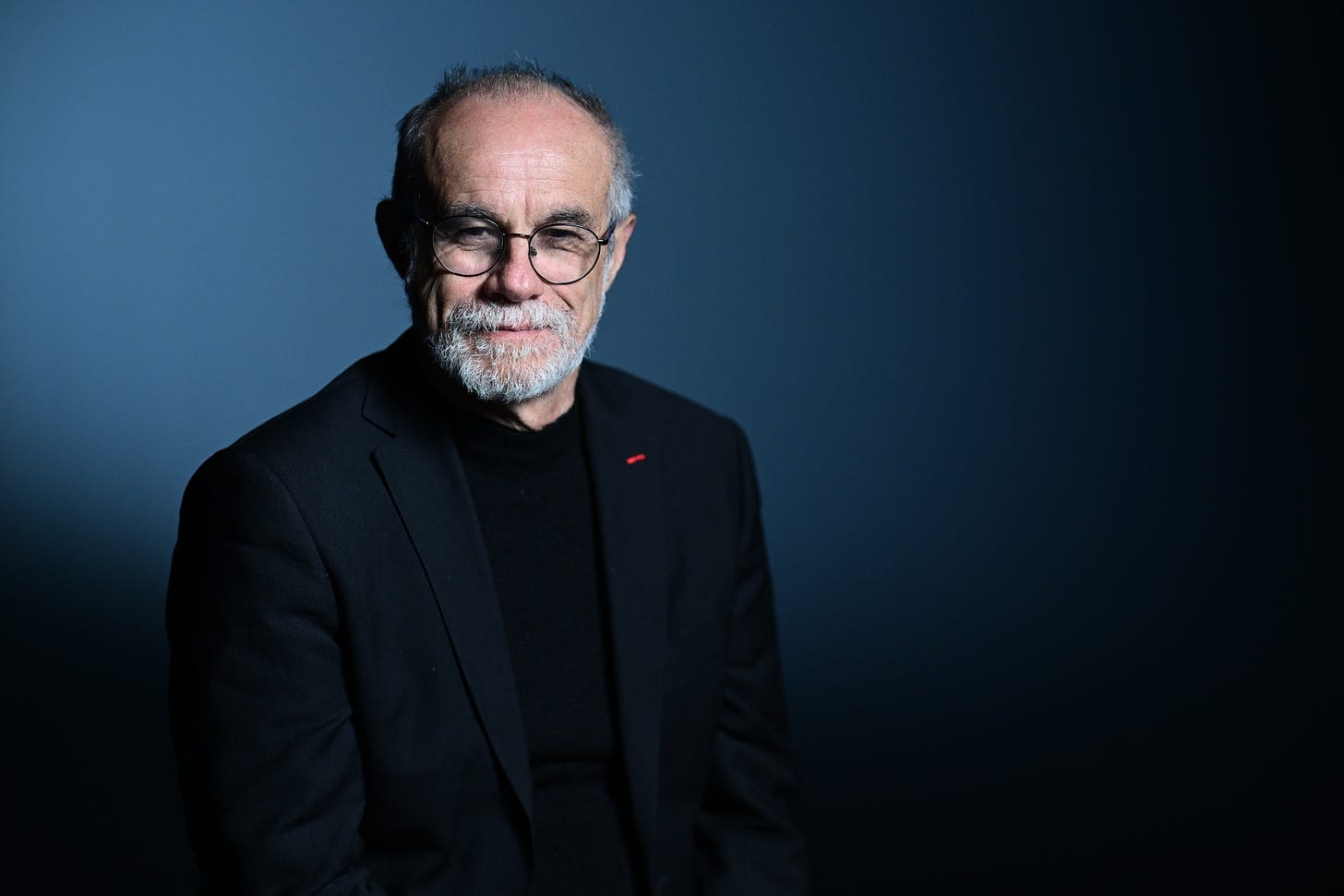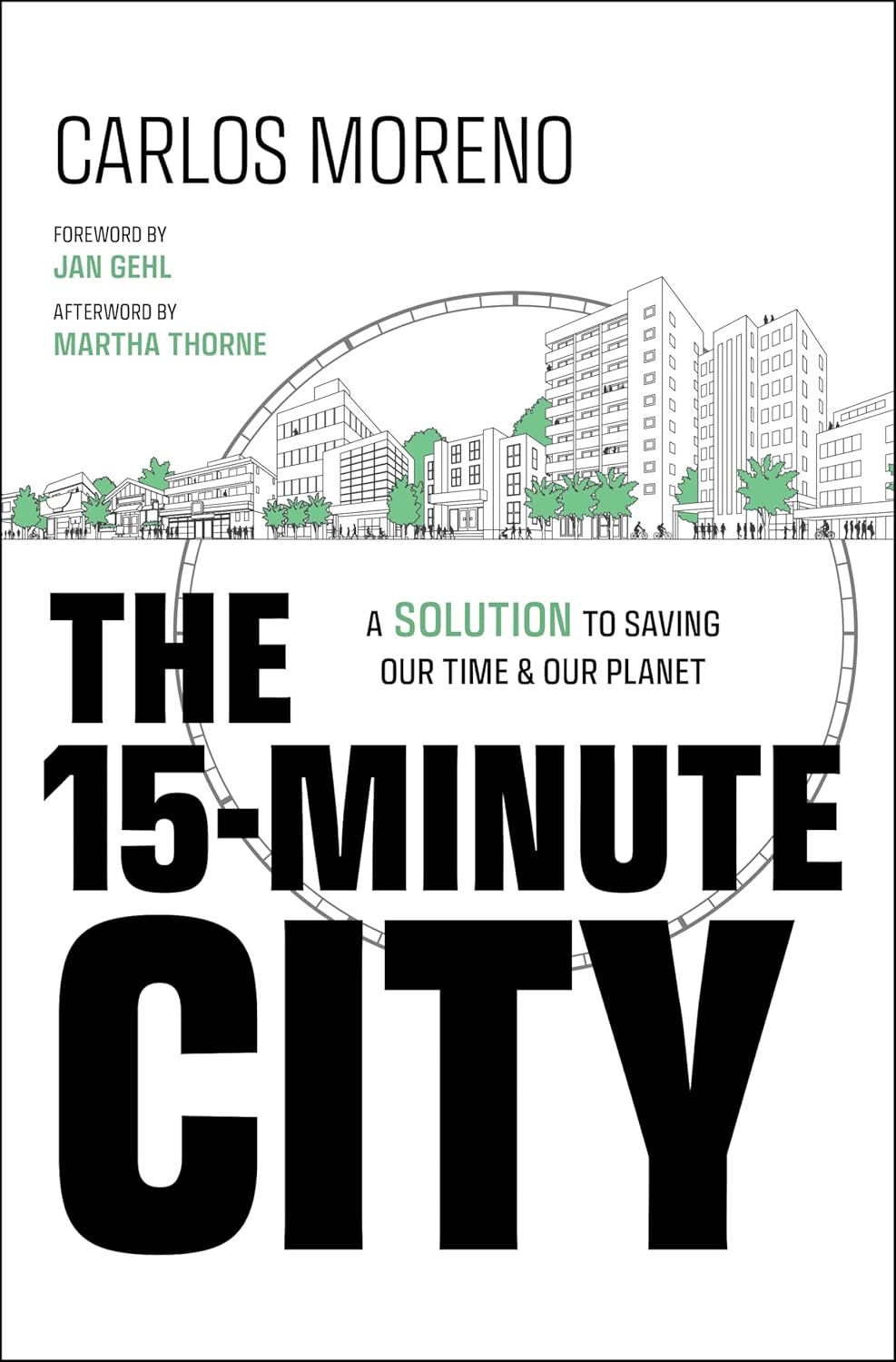
Who’s Afraid of the ‘15-Minute City’?
The originator of the urban planning concept expounds on his much-maligned idea.
The 15-Minute City
A Solution to Saving Our Time and Our Planet
by Carlos Moreno
Wiley, 276 pp., $28
THE TITULAR CONCEPT OF THE 15-MINUTE CITY—the idea that urban neighborhoods should be walkable and amenity-rich, so that pretty much all of what you need is fifteen minutes away—has attracted what might seem like an inordinate number of conspiracy theories. Before reading the book, written by the idea’s originator, Carlos Moreno, I was positive that the conspiracy theories surrounding the concept were meritless. After reading the book, I’m ever-so-slightly less sure.
Just to get you up to speed, the conspiracy theories go something like this: Bill Gates, Klaus Schwab (the German guy who runs the World Economic Forum), and a bunch of other people invented climate change to impoverish developed countries, crowd us into tiny apartments, and make us eat bugs. Then they invented COVID-19 and lockdowns to “trial-run” our forced urban future. And then they invented the “15-minute city,” a scheme to make the COVID lockdowns permanent, imprison people in their “complete neighborhoods,” and rob them of freedom of movement. If I’m overstating the conspiracy theories, it’s not by much.
As an urbanist who leans to the right politically, I tend to think that, at heart, the “15-minute city” is really just a modern, policy-wonk description of what any person before about 1950 would have understood to be simply a city. (Or a neighborhood, or a town, or a village.) The 15-minute city is chiefly not about density, but about proximity: Moreno gives examples from Paris all the way down to tiny European villages, whose mayors have attempted to enshrine easy, walkable access to most necessities, for most people, without the need for a car trip, as a planning priority.
Put this way, I don’t think there are many people who would oppose the idea. Who wants more traffic congestion? Who wants a longer drive to everyday services, retail, and amenities? Who wouldn’t like a shorter commute? What gives?
The issue is that Moreno does not always put it this way. Right from the start, with the brief description on the book’s dust jacket and a series of blurbs from other planners and urban scholars, the exact nature of the 15-minute city is unclear. Is it a succinct slogan for an ancient, traditional idea? A transformative innovation? A return to old wisdom? A fundamental reimagining of our cities?
The 15-minute city is called an “academic concept.” The book flap mentions “returning” to a lost urban way of life. But it also refers to a “new” and “innovative” way to live in cities. One blurb mentions “restoring” proximity to urban neighborhoods, but then praises “innovative ideas.” Another nods to forgotten urban wisdom but then adds that the modern 15-minute city concept is a way to “interpret these basic human needs into concept, and translat[e] that concept into policy.” One refers to an “ecological revolution.” There’s a reference to the “circular economy.” One blurb acknowledges that the 15-minute city is “old-fashioned,” but quickly adds that Moreno has refreshed it with “cutting-edge scientific findings on urban networks and complex adaptive systems.”
It’s as if there’s some shame in using plain, intuitive, relatable language—or that if it is used, it must quickly be amended with something academic, scientific, or impenetrably jargony.
Beyond that, there is definitely some conceptual confusion as to what even counts as “traditional” or “revolutionary” or “radical” or even “innovative.” This sentence, from Moreno, is a good example of this confusion: “Politicians and decision-makers remain attached to traditional models of urban development, and the ‘American way of life,’ and refused to make a major change in urban planning.”
By “traditional models of urban development” and “American way of life” Moreno means spread-out, car-dependent land use and transportation. But that system was essentially invented by the United States, and only really dates back to the first third of the twentieth century. Perhaps to a technocratic, left-leaning audience, “Suburbia was the real revolution!” won’t quite play. But that is historically more accurate, and to treat this rather unprecedented break with traditional urbanism as itself a traditional method adds an extra layer of confusion.
Perhaps the conspiracy theories, to give them the most charitable reading, arise as an attempt to interpret the odd and seemingly contradictory duality in the presentation of the 15-minute city concept. Yes, something old-fashioned and traditional can be radical and transformative, in a context in which it has been forgotten.
Hence the exchange I’ve had countless times with skeptics of the 15-minute city and other “new” urbanist ideas. “It’s just an urban neighborhood,” I say. “Then why does it need a new name and all this . . . stuff? It must be more than ‘just an urban neighborhood.’”
In other words, either the 15-minute city advocates really just mean “let cities be like they naturally were for all of human history up until the middle of the twentieth century”—in which case the jargon is superfluous—or they really do mean something beyond that, in which case perhaps the skepticism is warranted.
THE QUESTION THAT THE 15-MINUTE CITY and the controversy around it present is: Are elite urban planners and thinkers semi-secret technocratic authoritarians? Or are they simply a little too prideful to emphasize restoration, lost wisdom, and standing on the shoulders of giants? Which leads to a larger question: How much of our toxic political culture is an interplay between prideful progressive academics or policy scholars, bad-faith conservative entertainers, and ordinary people for whom jargon and unfamiliar language are obstacles to understanding?
Moreno, a Colombia-born French polymath urbanist, clearly doesn’t intend to stoke conspiracy theories. But he makes it too easy to read passages of the book in bad faith, as though he were either unaware of how any of it might sound to his detractors or the uninitiated, or uninterested in directly debunking their readings.
There is definitely material in the book that will make a regular, non-expert, center-right (or possibly center-left) reader pause, even if they are nowhere near believing the conspiracy theories.
COVID-19 lockdowns were a “test run” for forced urban living and restrictions on freedom of movement?
One chapter talks about “living zones” and a “15-minute life card.” One sentence, right after a bit about cities, mentions a “digital command-and-control platform.” Another reads: “During the health emergency, this concept was temporarily tested, but it is now destined to become a permanent transformation.” These kinds of phrases, put in front of readers who don’t understand the context, are apt to trigger paranoia about identity cards, planned economies, and oppression.
Ultimately, the lockdown connection runs mostly the other way: It was when the scrum of regular life stopped that a lot of people realized it was possible to still work and shop and live full lives while also spending less time on commutes, in traffic, in disconnected parts of the city or metro area. The focus on the home and the local area during the low point of the pandemic also meant more of a need for local businesses and services. It is as if the novel health crisis helped us to see a different way of doing things. What those who demand a complete snap-back to the pre-pandemic status quo are really asking is that we collectively pretend the last four years didn’t happen—that we forget what we learned about how people prefer to live and work.
The climate change hoax is the pretext for the 15-minute city?
Moreno cites “high energy consumption” as an “environmental challenge” that compact cities can help ameliorate. He explains that “the emergence of the 15-minute city concept is closely linked to the climate crisis.” He later brings up a “twin concept”: “the 30-minute territory, for medium and sparsely populated areas.” Do you really have to be a lunatic to imagine that this planning concept might, in the wrong hands, entail the forcible contraction of rural and suburban areas? Or, as the skeptics would ask: If it doesn’t mean that, what the hell does it mean? There’s a bit about “grouping” rural towns around cities—with your conspiracy glasses on, this could sound suspect. How would you “group” them “around” a city without moving them? Aren’t rural towns already grouped around cities organically? Hmm . . .
And here’s a nice tinfoil-hat trifecta: the IPCC, the WHO, and the broader U.N. all promote the 15-minute city.
AND THEN THERE’S THE JARGON. “Ecological time.” “As we explore the historical dimensions of urban temporality, it becomes evident that geography plays an equally pivotal role.” “Topophilia, chrono-urbanism, and chronotopia.” The 15-minute city approach “highlighted the need for a transversal and holistic vision of the city, aimed at creating a polycentric, multi-use and multi-service global projection.” “The in-depth development of this ontology provides an action plan in terms of uses and services, irrigating the whole city in a polycentric way.” “A perception of time that establishes a natural correlation between ourselves, the cosmos, and spirituality.”
Intelligibility induces trust. Unintelligible, weird language induces suspicion. That is not an attack on academic or scientific writing, or on policy white papers, or on expertise. But what is needed is a translator: somebody to distill all of the minute details and hyperspecialized study areas into something that sounds real, relatable, human.
Such translators exist in the broad urbanism movement: Charles Marohn and Jeff Speck, for example, write about basically the same ideas as Moreno, but addressed to lay audiences. But more translators are needed, and the irony is that conspiracy theorists pose as translators themselves: This is what these people really mean.
THERE IS, NONETHELESS, A GREAT DEAL TO LIKE about The 15-Minute City, both the book and the concept. Moreno is obviously passionate, and he is deeply knowledgeable and widely informed. His background in computer science leads him to be perhaps more of an analytical policy wonk than is typical for an urban planner, which isn’t a bad thing.
He does talk about experimenting and iterating—rather than imposing big schemes from the top down—and getting local people involved. He gives examples of cities all over the world, including the very different American cities of Portland and Cleveland. He includes a chapter on small towns, and nods to localism and business opportunity and entrepreneurship. He talks about scaling more things humanly (“human scale” being a popular urbanist idea), and about spending more time at rest, rooted in a place, knowing our communities.

Moreno also observes that raw density can have side effects, and that cities must be focused on a broader understanding of livability. He dislikes soulless apartment towers. He makes clear that the point is not to restrict mobility but to stop orienting our built environment around movement for its own sake: “Our aim is to move from forced mobility to chosen mobility.” He is training his fire not on the occasional jaunt down the open road, but against the daily, soul-crushing car commute.
The most important thing to realize about the 15-minute city is that overwhelmingly, it is not about urbanizing or abolishing the suburbs, but about enabling the city to truly be the city. It is not so much a general planning guide as an existing-city improvement manual. There is little in this book that anybody reading in good faith could honestly take to mean that rural or suburban areas should no longer exist, that long-range commuting should be banned, or any of the more extreme characterizations. Moreno’s point is that the city itself should be truly urban, rather than an echo of suburbia, a collection of disconnected car-oriented sites and pieces of infrastructure.
Moreno puts this explicitly when he champions the value of proximity “so that city living can be seriously considered.” In other words, almost all places today—rural, suburban, or urban—lack the proximity and ease of access that characterized a pre-automobile city. However much urbanists might sometimes drag suburbia, the fact is that we mostly don’t want to get rid of it or take it away. We just want it not to be the exclusive option.
And, contra some of the left-leaning anti-gentrification discourse, this is not about an elite lifestyle revolution for new arrivals to the city. It is also for everyone who is already there. Fewer than a quarter of Parisians own a car, Moreno observes. (The car ownership rate is similar in Manhattan.) Moreno makes a point that may not be obvious to the majority of people living outside of urban cores, especially in the United States: car-oriented land use closes off opportunity for urbanites, because they are less likely to own a car, but a majority of regional jobs are likely to be found outside the urban core. In other words, there is an economic opportunity argument to be made for proximate, compact urbanism, not just a lifestyle one or an environmental one. And relatedly, urbanism should be seen chiefly as a movement for urbanites and their own communities, rather than a movement to reshape every other place.
Unfortunately, this is not articulated as clearly in The 15-Minute City as it could be. When I listen to the conspiracy theorists quoting the academic jargon as proof that something is afoot, I have a hard time blaming only the conspiracy theorists. The authors, scholars, and activists who do not communicate in plain language are concealing and disguising their own sensible ideas in a manner that can lead normal people to grow suspicious. How much better it would be to speak plainly about how this is an idea that will make it easier for more people to live happier, easier, freer lives.

















